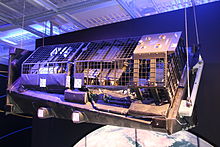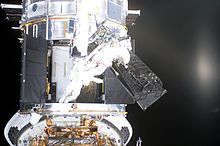Faint Object Camera
Appearance



The Faint Object Camera (FOC) was a camera installed on the Hubble Space Telescope from launch in 1990 until 2002. It was replaced by the Advanced Camera for Surveys.
The camera was built by Dornier GmbH and was funded by the European Space Agency. The unit actually consists of two complete and independent camera systems designed to provide extremely high resolution, exceeding 0.05 arcseconds. It is designed to view very faint UV light from 115 to 650 nanometers in wavelength.[1]
The camera was designed to operate at low, medium, or high resolution. The angular resolution and field of view at each resolution were as follows[2]:
| Angular resolution | Field of view | |
|---|---|---|
| Low resolution (f/48) | 0.043 arcseconds | 22 arcseconds |
| Medium resolution (f/96) | 0.022 arcseconds | 11 arcseconds |
| High resolution (f/288) | 0.0072 arcseconds | 3.6 arcseconds |
Mira

References
- ^ The Space Telescope Observatory (Technical report). NASA. 1982. CP-2244., page 40. A 40 MB PDF file.
- ^ "FOC - Faint Object Camera". Hubble. European Space Agency. 2006-12-12. Retrieved 2007-02-07.


